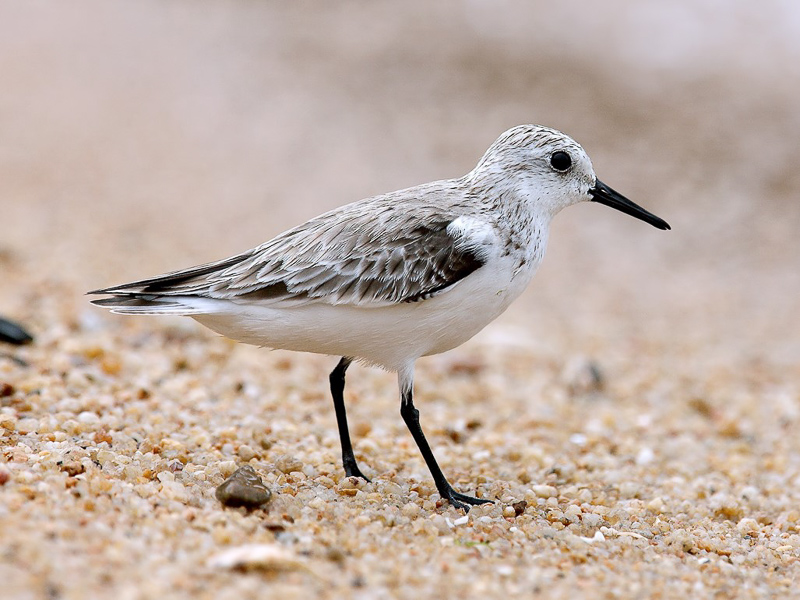Sanderling Calidris alba 三趾濱鷸
Category I. Passage migrant, scarce to uncommon in spring but rare in winter; occurs in intertidal areas of Deep Bay but rarely on sandy beaches.
IDENTIFICATION

Apr. 2008, Michelle and Peter Wong. Non-breeding plumage.
18-20 cm. Larger than stints, but slightly smaller than Curlew Sandpiper, compared to which it is much more compact. The bill and legs are black, while the feet lack a hind toe.
Most birds seen in HK in spring are largely in winter plumage. The upperparts are rather pale grey, often with blackish at the bend of the closed wing, and the underparts from throat to undertail coverts are pure white with only faint greyish streaks at the side of the chest.

May 2014, Michelle and Peter Wong. Breeding plumage.
Moult to breeding plumage results in darker and more distinct streaks and orange-brown on the chest, throat and face. Dark centred upperpart feathers appear with large orange-brown blotches, though it is rare for birds in HK to be entirely in breeding plumage. However, a bird seen as early as 8 April had completed this moult.

Sep. 2022, Sarawak, Malaysia. Dave Bakewell. Juvenile.
In juvenile plumage the mantle and scapulars have blackish arrowhead centres that reach the edge of the feather, which are outlined by broad buff or whitish fringes. This is rather different from the evenly scaled pattern of juvenile stints.
VOCALISATIONS
Calls include a somewhat explosive and loud ‘pwit’ and a high-pitched ‘chit’.
DISTRIBUTION & HABITAT PREFERENCE
Elsewhere in the world Sanderling is associated with sandy beaches, but it would appear that a combination of disturbance and the relative inaccessibility of undisturbed sites means that few are recorded in this habitat in HK. Most records are from the intertidal mudflats of Deep Bay and adjacent roosting areas of Mai Po NR, but it is very rare on the nearby commercial fish ponds.
Away from Deep Bay other records are mostly of up to eight birds (though generally only one or two) at scattered coastal localities mainly in the New Territories, but also on Lantau (Pui O and Shui Hau), Lamma, Po Toi, Tung Ping Chau (where 15 were present on 27 April 2008) and at the airport sites of Kai Tak and Chek Lap Kok. At the sandy beaches at Tai Long Wan and Long Ke Wan, Sai Kung there have been spring records of up to seven birds, and one autumn record of a single. The highest count away from Deep Bay is a flock of 19 over the southern waters of Hong Kong on 5 May 2018
OCCURRENCE
Sanderling is primarily a spring passage migrant though the numbers involved are low, with over 90% of records involving fewer than five birds. The earliest spring record is of one at Mai Po NR on 12 March 2017. Passage peaks in the last week of April and first half of May (Figure 1), with the highest spring count being 67 on 4 May 1993. Spring 1993 was exceptional for this species, however, and the highest count in other years is 19 on 5 May 2018. The latest record concerns one on 8 June 2004.
It is rare on autumn passage, and almost all records involve only one or two birds, the highest counts being ten on 16 November 1958 and eight on 21 November 1976; the highest count this century is four on 21 November 2001. The earliest autumn records occurred on 8 August 2010 and 26 August 1962, and the latest on 22 November 2009.
Figure 2 charts the peak spring and autumn counts. There appears to have been a decline in numbers, with the peak count usually five or more before 2009 but fewer than that subsequently.
There are four winter records: two on 26 January 1964 and singles on 20 December 2016, 16 January 1983 and 15 January 1990.
Confusion regarding separation of Sanderling from some Red-necked Stints in spring means that many early records must be considered unreliable.
Sanderlings bearing leg-flags attached in Victoria, Australia have been recorded from 23 April to 16 May.
BEHAVIOUR, FORAGING & DIET
Forages mainly by picking prey from surface, though also probes. Presumably feeds on small crustaceans and molluscs when on sandy beaches.
RANGE & SYSTEMATICS
Two subspecies are recognised, and it is presumed that birds recorded in HK are C. a. rubida, which breeds in northeast Siberia, Alaska and northern Canada. The nominate taxon breeds from Ellesmere Island east through Greenland, Svalbard and Franz Josef Land to Taymyr.
Has a circumpolar breeding distribution that is concentrated in northern Canada, Ellesmere Island and adjacent northwest Greenland, as well as in Ellesmere Island and the Taymyr region. It winters along almost all coasts in the southern hemisphere, as well as northern hemisphere coastlines as far north as Vancouver, the U.K. and South Korea (Macwhirter et al. 2020). In China it is a migrant through much of the country and winters along the south coast, including Hainan and Taiwan (Liu and Chen 2021). However, it does not typically winter in HK.
CONSERVATION STATUS
IUCN: Least Concern. Population trend unknown.
Figure 1.

Figure 2.

Liu, Y. and S. H. Chen (eds) (2021). The CNG Field Guide to the Birds of China (in Chinese). Hunan Science and Technology Publication House, Changsha.
Macwhirter, R. B., P. Austin-Smith Jr., and D. E. Kroodsma (2020). Sanderling (Calidris alba), version 1.0. In Birds of the World (S. M. Billerman, Editor). Cornell Lab of Ornithology, Ithaca, NY, USA. https://doi.org/10.2173/bow.sander.01

